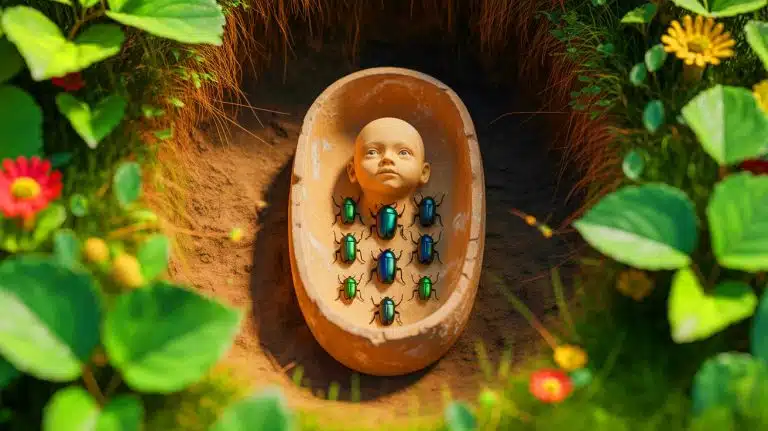| IN A NUTSHELL |
|
In the southwestern region of Poland, archaeologists have uncovered an extraordinary discovery that offers a new perspective on ancient burial rituals. Hidden in a child’s funerary urn dating back 2,500 years, researchers found an object of delicate beauty: fragments of beetle exoskeletons. This unexpected find, located in the Domasław cemetery, has the potential to reshape our understanding of the Hallstatt culture’s practices and beliefs. The meticulous arrangement of these beetle fragments suggests a purposeful creation, possibly a necklace or ornament, meant to accompany a child into the afterlife. This discovery not only highlights the intricate craftsmanship of ancient societies but also raises intriguing questions about the symbolic meanings attributed to such objects.
A Unique Discovery in Tomb 543
Between 2005 and 2007, a team of archaeologists explored over 800 graves at the expansive Domasław cemetery, dating from 850 to 400 BCE. Among these, Tomb 543 stood out due to its remarkable contents. Within an urn holding the cremated remains of a child approximately ten years old, the team discovered a bronze fibula, birch bark fragments, animal bones, and notably, 17 fragments of beetle exoskeletons. This collection appeared to be intentionally arranged, with some fragments threaded onto a blade of grass, resembling a potential necklace or ornamental piece.
Detailed analysis identified the beetle species as Phyllobius viridicollis, a green weevil still found in Europe today. The discovery of twelve intact pronota— the beetle’s shield-like thoracic plates— and five additional fragments suggests a deliberate selection and preparation process. Such findings indicate that the ancient inhabitants of Domasław may have imbued these beetle fragments with significant symbolic or ritualistic meaning, intended to aid the child in their journey to the afterlife.
A Funeral Ornament with Multiple Meanings
The intentional modification of the beetle fragments for burial purposes is a point of fascination for researchers. The beetles had been altered, with heads, legs, and abdomens removed, while thoracic plates were preserved and assembled. This intentionality hints at the creation of a ritualistic jewel designed for the child's passage into the afterlife. The preservation of these organic remains is a stroke of archaeological luck. The corrosion of the bronze fibula released copper compounds that permeated the beetle shells, preventing decomposition. This chemical reaction, alongside electron microscope analyses, has provided archaeologists with a rare glimpse into an object that would typically have vanished over millennia.
Beyond symbolism, the researchers could also determine the burial season. The presence of these beetles, which emerge in spring and disappear by summer, alongside dandelion pollen found in the urn, suggests the child was buried during the warmer months. This timing aligns with specific natural cycles, adding another layer of significance to the burial practices of the time.
Insects: A Blend of Beauty and Magic
The use of insects in funerary ornaments is not exclusive to Poland. Similar practices are found in other cultures. In Ukraine and Romania, the Hutsuls traditionally crafted beetle necklaces believed to offer protection, while during the Victorian era, iridescent beetle wings were fashionable in jewelry. A recent discovery in South Korea unveiled a 1,400-year-old crown adorned with beetle wings, further illustrating this widespread cultural phenomenon.
In Domasław, the precise symbolism of the beetle fragments remains elusive. However, researchers speculate that the object combined aesthetic value with spiritual symbolism. Beetles are often associated with transformation and life's cyclical nature, serving as potential talismans for the child's journey into the afterlife. This exceptional find emphasizes that prehistoric societies expressed themselves not only through stone or metal but also through ephemeral objects, as delicate as a fragment of an insect.
Preservation Through Unlikely Chemistry
The preservation of the beetle exoskeletons in Tomb 543 owes much to an unlikely chemical process. The bronze fibula's corrosion released copper compounds that interacted with the beetle fragments, essentially preserving them for millennia. This unexpected preservation provides a rare opportunity to study organic materials from an era where such items typically decompose entirely. Electron microscopy further aided researchers in understanding the construction and composition of these ancient adornments.
The discovery underscores the importance of serendipity in archaeological research. It also highlights the potential for modern scientific techniques to uncover and analyze materials that once seemed lost to time. As researchers continue to explore these findings, they offer a more nuanced view of how ancient peoples understood and interacted with their natural world.
The discovery at Domasław raises profound questions about the cultural practices and beliefs of ancient societies. As researchers continue to analyze these findings, they may uncover further insights into the symbolic meanings and ritualistic practices of the Hallstatt culture. This fascinating intersection of archaeology and chemistry opens doors to deeper understandings of the past. What other secrets might lie buried, waiting for modern science to uncover them?
Did you like it? 4.4/5 (23)







Wow, beetles as jewelry? That’s a new one! 🪲
Wow, beetle jewelry? That’s a new one. 🪲
Is this the first time beetle exoskeletons have been found like this?